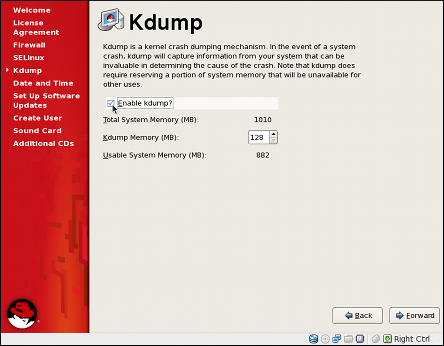Questo contenuto non è disponibile nella lingua selezionata.
46.2. Configuring the kdump Service
There are three common means of configuring the
kdump service: you can enable and configure it at the first boot, use the Kernel Dump Configuration utility for the graphical user interface, or do so manually on the command line.
Important
A limitation in the current implementation of the
Intel IOMMU driver can occasionally prevent the kdump service from capturing the core dump image. To use kdump on Intel architectures reliably, it is advised that the IOMMU support is disabled.
Warning
It is known that the
kdump service does not work reliably on certain combinations of HP Smart Array devices and system boards from the same vendor. Consequent to this, users are strongly advised to test the configuration before using it in production environment, and if necessary, configure kdump to store the kernel crash dump to a remote machine over a network. For more information on how to test the kdump configuration, refer to Section 46.2.4, “Testing the Configuration”.
46.2.1. Configuring kdump at First Boot
Copia collegamentoCollegamento copiato negli appunti!
When the system boots for the first time, the
firstboot application is launched to guide the user through the initial configuration of the freshly installed system. To configure kdump, navigate to the Kdump page and follow the instructions below.
Important
Unless the system has enough memory, the Kdump page will not be available. For information on minimum memory requirements, refer to the Red Hat Enterprise Linux comparison chart. When the
kdump crash recovery is enabled, the minimum memory requirements increase by the amount of memory reserved for it. This value is determined by the user and on x86, AMD64, and Intel 64 architectures, it defaults to 128 MB plus 64 MB for each TB of physical memory (that is, a total of 192 MB for a system with 1 TB of physical memory).
Figure 46.1. The kdump configuration screen
46.2.1.1. Enabling the Service
Copia collegamentoCollegamento copiato negli appunti!
To start the
kdump daemon at boot time, select the Enable kdump? checkbox. This will enable the service for runlevels 2, 3, 4, and 5, and start it for the current session. Similarly, clearing the checkbox will disable it for all runlevels and stop the service immediately.
46.2.1.2. Configuring the Memory Usage
Copia collegamentoCollegamento copiato negli appunti!
To configure the amount of memory that is reserved for the
kdump kernel, click the up and down arrow buttons next to the Kdump Memory field to increase or decrease the value. Notice that the Usable System Memory field changes accordingly showing you the remaining memory that will be available to the system.
